Multi-Objective Optimization of Laser Cleaning Quality of Q390 Steel Rust Layer Based on Response Surface Methodology and NSGA-II Algorithm
Abstract
:1. Introduction
2. Experimental Conditions and Methods
2.1. Materials and Equipment
2.2. Experimental Design
3. Effects of Parameters on Quality Characteristics
3.1. Mathematical Relationships and Analysis of Variance
3.2. Effects of Parameters of Laser Cleaning and Rust Removal Process on Surface Quality
3.2.1. Effects of Process Parameters on Oxygen Content
3.2.2. Effects of Process Parameters on Removal Rate
3.2.3. Effects of Process Parameters on Roughness
3.3. Optimization of Surface Quality Characteristics after Cleaning Based on NSGA-II
3.4. Optimization Results and Validation of Surface Quality and Laser Process Parameters
4. Conclusions
- (1)
- The relationship between the objective value and the input variables had been effectively represented by the proxy mode based on the response surface, and evaluation parameters such as the p-value, F-value, and signal-to-noise ratio indicated that the proxy model was well fitted.
- (2)
- The pattern of the influence of each single factor on the surface cleaning quality after secondary laser cleaning was analyzed, along with the influence pattern for the interaction of laser power, cleaning speed, scanning speed, and repetition frequency. For the surface oxygen content, the single factors with the most significant influence were the cleaning speed and laser power, and the median value of each process parameter could be selected to minimize the oxygen content. Regarding the surface removal rate, the combination of a low cleaning speed, high laser power, and low scanning speed resulted in the highest removal rate. The single factor most significantly affecting the surface roughness was the laser power, and the surface roughness could be reduced by increasing the scanning speed and repetition frequency.
- (3)
- On the basis of the mathematical model constructed using the response surface, NSGA-II was employed to find the optimum, from which good objective values were obtained, and the optimal process parameters were obtained as follows: a laser power of 44.99 W, cleaning speed of 174.01 mm/min, scanning speed of 3852.03 mm/s, and repetition frequency of 116 kHz.
Author Contributions
Funding
Institutional Review Board Statement
Informed Consent Statement
Data Availability Statement
Conflicts of Interest
Appendix A
Appendix A.1. Computational Formul
Appendix A.2. Response Surface Multi-Objective Optimization Results
| No | P/W | Vy/(mm/min) | Vx (mm/s) | f/kHz | O% | E% | R% | E% | Sa/µm | E% | |||
|---|---|---|---|---|---|---|---|---|---|---|---|---|---|
| Pre | Act | Pre | Act | Pre | Act | ||||||||
| 1 | 37.168 | 162.73 | 3354.06 | 120 | 8.841 | 9.294 | 4.8% | 94.81 | 90.12 | 5.23% | 3.390 | 3.7812 | 10.34% |
| 2 | 44.845 | 183.442 | 4834.93 | 120 | 8.027 | 9.812 | 18.1% | 93.30 | 91.56 | 1.90% | 3.681 | 3.8754 | 5.01% |
| 3 | 37.232 | 163.63 | 3311.70 | 119 | 8.766 | 8.156 | 7.47% | 94.75 | 89.22 | 6.19% | 3.402 | 3.7185 | 8.51% |
References
- Zhang, Y.; Lan, L.; Shi, Q. Correlation between Weld Metal Microstructure Evolution and Welding Process Parameters of Low Alloy Ferritic Steel Weldments. Steel Res. Int. 2023, 94, 2200797. [Google Scholar] [CrossRef]
- Cheng, X.; Gu, X.; Bie, G.; Yang, J.; Zhou, J.s.; Liu, C. Influence of ultrasonic shock treatment and post-welding heat treatment on welding residual stress of large thickness nuclear power structural steel. Weld. Technol. 2022, 47, 5. [Google Scholar] [CrossRef]
- Li, X.; Li, C.; Wang, D.; Lei, Y.; Li, M.; Huang, W. Effect of Laser Scanning Speeds on Cleaning Quality of Rusted Layer on Q345 Steel Surface. Chin. J. Lasers 2020, 47, 1002010. [Google Scholar] [CrossRef]
- Zhu, G.; Xu, Z.; Jin, Y.; Chen, X.; Yang, L.; Xu, J.; Shan, D.; Chen, Y.; Guo, B. Mechanism and application of laser cleaning: A review. Opt. Lasers Eng. 2022, 157, 107130. [Google Scholar] [CrossRef]
- Hecht, C.; Slama, J.-N.; Sprenger, M.; HauBler, F.; Sippel, M.; Franke, J. Laser Cleaning of Flux Residues on Copper Surfaces in Electronics Production. In Proceedings of the 2022 IEEE 28th International Symposium for Design and Technology in Electronic Packaging (SIITME), Bucharest, Romania, 26–29 October 2022; pp. 65–69. [Google Scholar]
- Chen, L.; Lingfei, J.; Yan, W.; Qiurui, L.; Yijian, J.; Kai, Y. Research and Mechanism Study on Refurbishing Stainless Bracket Using Picosecond Laser Based on Laser Cleaning Technology. Chin. J. Lasers 2014, 41, 84–90. [Google Scholar] [CrossRef]
- AlShaer, A.W.; Li, L.; Mistry, A. The effects of short pulse laser surface cleaning on porosity formation and reduction in laser welding of aluminium alloy for automotive component manufacture. Opt. Laser Technol. 2014, 64, 162–171. [Google Scholar] [CrossRef]
- Li, Z.; Zhang, D.; Su, X.; Yang, S.; Xu, J.; Ma, R.; Shan, D.; Guo, B. Removal mechanism of surface cleaning on TA15 titanium alloy using nanosecond pulsed laser. Opt. Laser Technol. 2021, 139, 106998. [Google Scholar] [CrossRef]
- Bertasa, M.; Korenberg, C. Successes and challenges in laser cleaning metal artefacts: A review. J. Cult. Herit. 2022, 53, 100–117. [Google Scholar] [CrossRef]
- Ma, M.; Wang, L.; Li, J.; Jia, X.; Wang, X.; Ren, Y.; Zhou, Y. Investigation of the Surface Integrity of Q345 Steel After Nd:YAG Laser Cleaning of Oxidized Mining Parts. Coatings 2020, 10, 716. [Google Scholar] [CrossRef]
- Lu, Y.; Ding, Y.; Wang, G.; Yang, L.; Wang, M.; Wang, Y.; Guo, B. Ultraviolet laser cleaning and surface characterization of AH36 steel for rust removal. J. Laser Appl. 2020, 32, 032023. [Google Scholar] [CrossRef]
- Narayanan, V.; Singh, R.K.; Marla, D.; Kondo, Y. Laser cleaning for rust removal on mild steel: An experimental study on surface characteristics. MATEC Web Conf. 2018, 221, 01007. [Google Scholar] [CrossRef]
- Wu, Q.; Sun, X.; Sun, J.; Han, L.; Liu, L. Effect of Continuous Laser Cleaning Process Parameters on Surface Quality of Q235B Carbon Steel Rust Layer. Laser Optoelectron. Prog. 2023, 60, 2314002. [Google Scholar] [CrossRef]
- Zhang, Y.; Xu, Y.; Sun, Y.; Cheng, W. Surface quality optimization of laser cladding based on surface response and genetic neural network model. Surf. Topogr. Metrol. Prop. 2022, 10, 044007. [Google Scholar] [CrossRef]
- Yanyan, W.; Jiahao, L.; Linsen, S.; Chengming, S. Multi-Objective Optimization of Laser Cladding Parameters Based on RSM and NSGA-II Algorithm. Laser Optoelectron. Prog. 2022, 59, 195–201. [Google Scholar] [CrossRef]
- Shu, L.; Li, J.; Wu, H.; Heng, Z. Optimization of Multi-Track Laser-Cladding Process of Titanium Alloy Based on RSM and NSGA-II Algorithm. Coatings 2022, 12, 1301. [Google Scholar] [CrossRef]
- Meng, G.; Zhu, L.; Zhang, J.; Yang, Z.; Xue, P. Statistical analysis and multi-objective process optimization of laser cladding TiC-Inconel718 composite coating. Optik 2021, 240, 166828. [Google Scholar] [CrossRef]
- Yang, Y.; Cao, L.; Wang, C.; Zhou, Q.; Jiang, P. Multi-objective process parameters optimization of hot-wire laser welding using ensemble of metamodels and NSGA-II. Robot. Comput.-Integr. Manuf. 2018, 53, 141–152. [Google Scholar] [CrossRef]
- Tong, Y. Basic Research on Mechanism and Application of Laser Removal of Metal Oxides. Ph.D. Thesis, Jiangsu University, Zhenjiang, China, 2014. [Google Scholar]
- Hipp, D.; Mahrle, A.; Beyer, E. Beyond Fresnel: Absorption of fibre laser radiation on rough stainless steel surfaces. J. Phys. D Appl. Phys. 2019, 52, 355302. [Google Scholar] [CrossRef]
- Li, Y.; Založnik, M.; Zollinger, J.; Dembinski, L.; Mathieu, A. Effects of the powder, laser parameters and surface conditions on the molten pool formation in the selective laser melting of IN718. J. Mater. Process. Technol. 2021, 289, 116930. [Google Scholar] [CrossRef]
- Ding, H.; Wang, Z.; Guo, Y. Multi-objective optimization of fiber laser cutting based on generalized regression neural network and non-dominated sorting genetic algorithm. Infrared Phys. Technol. 2020, 108, 103337. [Google Scholar] [CrossRef]
- Zhu, M.; Zhou, J.; Meng, X.; Sun, Q.; Gao, L.; Li, H.; Guo, Z.; Yang, J.; Fu, Q. Optimization of Laser Cleaning Process Parameters for Q345C Steel Rust Layer Based on Response Surface. Surf. Technol. 2019, 48, 381–391. [Google Scholar] [CrossRef]
- Javid, Y. Multi-response optimization in laser cladding process of WC powder on Inconel 718. CIRP J. Manuf. Sci. Technol. 2020, 31, 406–417. [Google Scholar] [CrossRef]
- Ragavendran, M.; Chandrasekhar, N.; Ravikumar, R.; Saxena, R.; Vasudevan, M.; Bhaduri, A.K. Optimization of hybrid laser—TIG welding of 316LN steel using response surface methodology (RSM). Opt. Lasers Eng. 2017, 94, 27–36. [Google Scholar] [CrossRef]
- Zhang, W.; Huang, Z.; Kang, M.; Shi, M.; Deng, R.; Yan, Y.; Zhu, Q. Research on multivariate nonlinear regression model of specific energy of rock with laser drilling based on response surface methodology. Opt. Commun. 2021, 489, 126865. [Google Scholar] [CrossRef]
- Liu, H.; Yang, W.; Wang, D.; Yao, Y.; Chi, Y. Effects of Laser Energy Density on Cleaning Effect and Mechanism of TWIP Steel Surface Oxide. J. Med. Libr. Assoc. 2024, 100 (Suppl. 4). [Google Scholar]
- Peng, S.; Li, T.; Zhao, J.; Lv, S.; Tan, G.Z.; Dong, M.; Zhang, H. Towards energy and material efficient laser cladding process: Modeling and optimization using a hybrid TS-GEP algorithm and the NSGA-II. J. Clean. Prod. 2019, 227, 58–69. [Google Scholar] [CrossRef]
- Chaki, S.; Bathe, R.N.; Ghosal, S.; Padmanabham, G. Multi-objective optimisation of pulsed Nd:YAG laser cutting process using integrated ANN–NSGAII model. J. Intell. Manuf. 2015, 29, 175–190. [Google Scholar] [CrossRef]
- Zhang, D.; Liu, Z.; Song, K.; Zhai, Z.; Zhang, Y.; Gao, Z. Parameters optimization for laser-cladding CoCrFeNiMn high-entropy alloy layer based on GRNN and NSGA-II. Mater. Today Commun. 2024, 39, 108615. [Google Scholar] [CrossRef]
- Luo, D.; Liu, C.; Wang, C.; Wang, Y.; Wang, X.; Zhao, J.; Jiang, S. Optimization of multilayer laser cladding process parameters based on NSGA-II-MOPSO algorithm. Opt. Laser Technol. 2024, 176, 111025. [Google Scholar] [CrossRef]
- Rafiei, J.; Soheil Shamaee, M.; Ghasemi, A.R. Process parameter optimization of WC/Inconel 625 metal matrix composites laser cladding based on the Taguchi approach and NSGA-II algorithm. Soft Comput. 2024. [Google Scholar] [CrossRef]
- Libin, N.; Jichang, L.; Yaoting, W.; Cuo, Y. Optimization of Laser Cladding Process V ariables Based on Neural Network and Particle Swarm Optimization Algorithms. Chin. J. Lasers 2011, 38, 99–104. [Google Scholar] [CrossRef]
- Qin, H.; Pang, X. Novel method to design laser beam shaping lenses using PSO techniques. Appl. Phys. B 2018, 125, 7. [Google Scholar] [CrossRef]
- Yifan, P.; Geyan, F.; Mingyu, W.; Yanqi, G.; Siqi, Y.; Jiachao, X.; Fan, L. Parameter Optimization of High Deposition Rate Laser Cladding Based on the Response Surface Method and Genetic Neural NetworkModel. Chin. J. Lasers 2021, 48, 152–162. [Google Scholar] [CrossRef]
- Liu, F.; Chen, Y.; Qin, W.; Li, J. Optimal design of liquid cooling structure with bionic leaf vein branch channel for power battery. Appl. Therm. Eng. 2023, 218, 119283. [Google Scholar] [CrossRef]
- Conghui, Z.; Hua, R.; Guodong, S.; Kun, H. Effect of Surface Roughness by Shot Peening on Stress Corrosion Cracking Behavior of Pure Titanium Welded Joints in HCl Solution. Acta Metall. Sin. 2019, 55, 1282–1290. [Google Scholar] [CrossRef]
- Junhoong, C.; Peng, W.; Baohua, C.; Jiguo, S.; Dong, D.; Hao, C. Laser Cleaning of Titanium Alloy and Its Effect on Laser Welding Porosity. China Mech. Eng. 2020, 31, 379–383. [Google Scholar] [CrossRef]
- ISO8501-1-2007; Preparation of Steel Substrates before Application of Paints and Related Products Visual Assessment of Surface Cleanliness, Part 1: Rust Grades and Preparation Grades of Uncoated Steel Substrates and of Steel Substrates after Overall Removal of Previous Coatings. International Organization for Standardization: Geneva, Switzerland, 2007.
- Zhou, J.; Li, H.; Sun, Q.; Meng, X.; Fu, Q. Laser derusting mechanism of AH32 steel based oncleaned surface topography. Opt. Precis. Eng. 2019, 27, 1754–1764. [Google Scholar] [CrossRef]
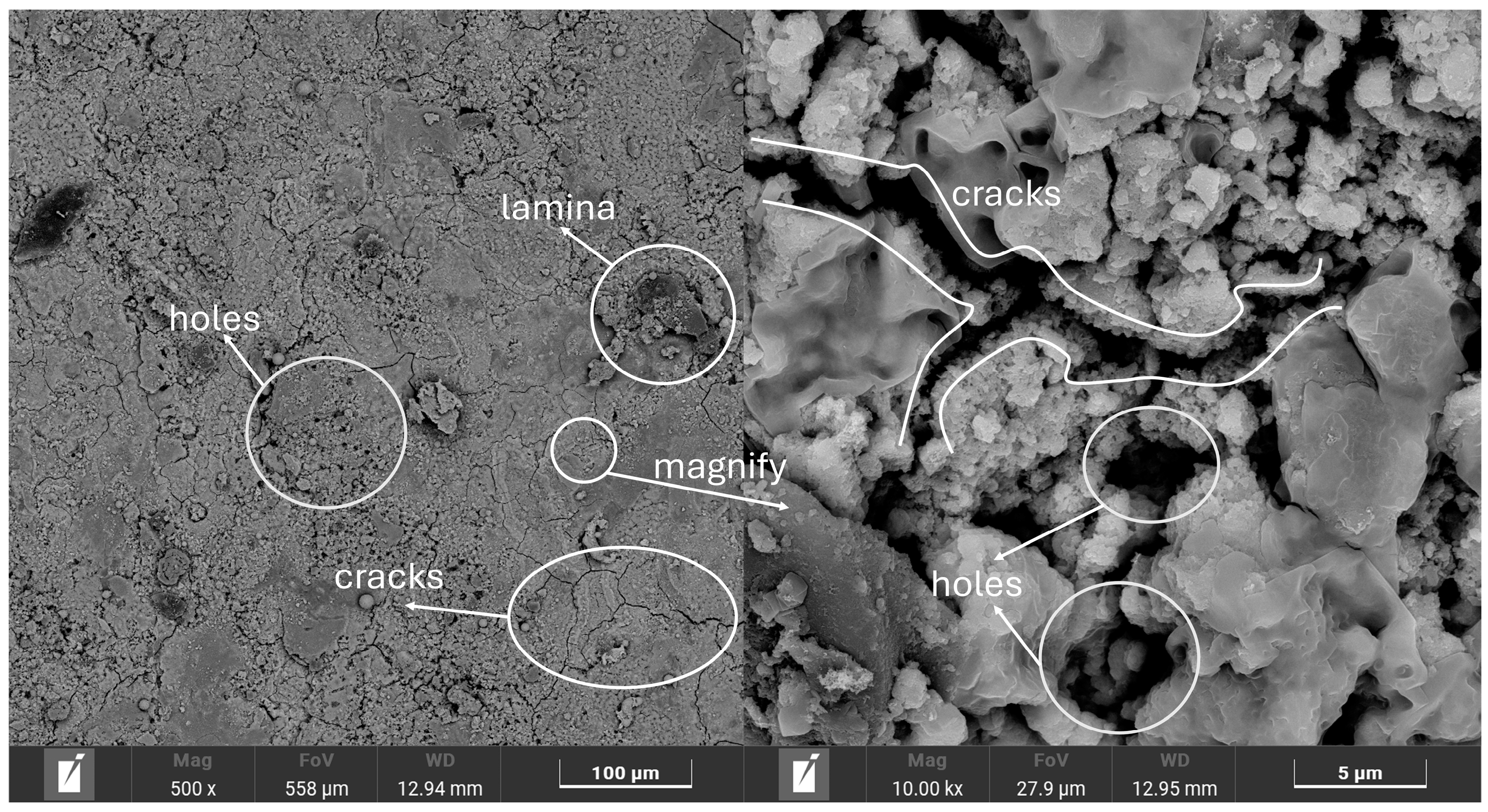
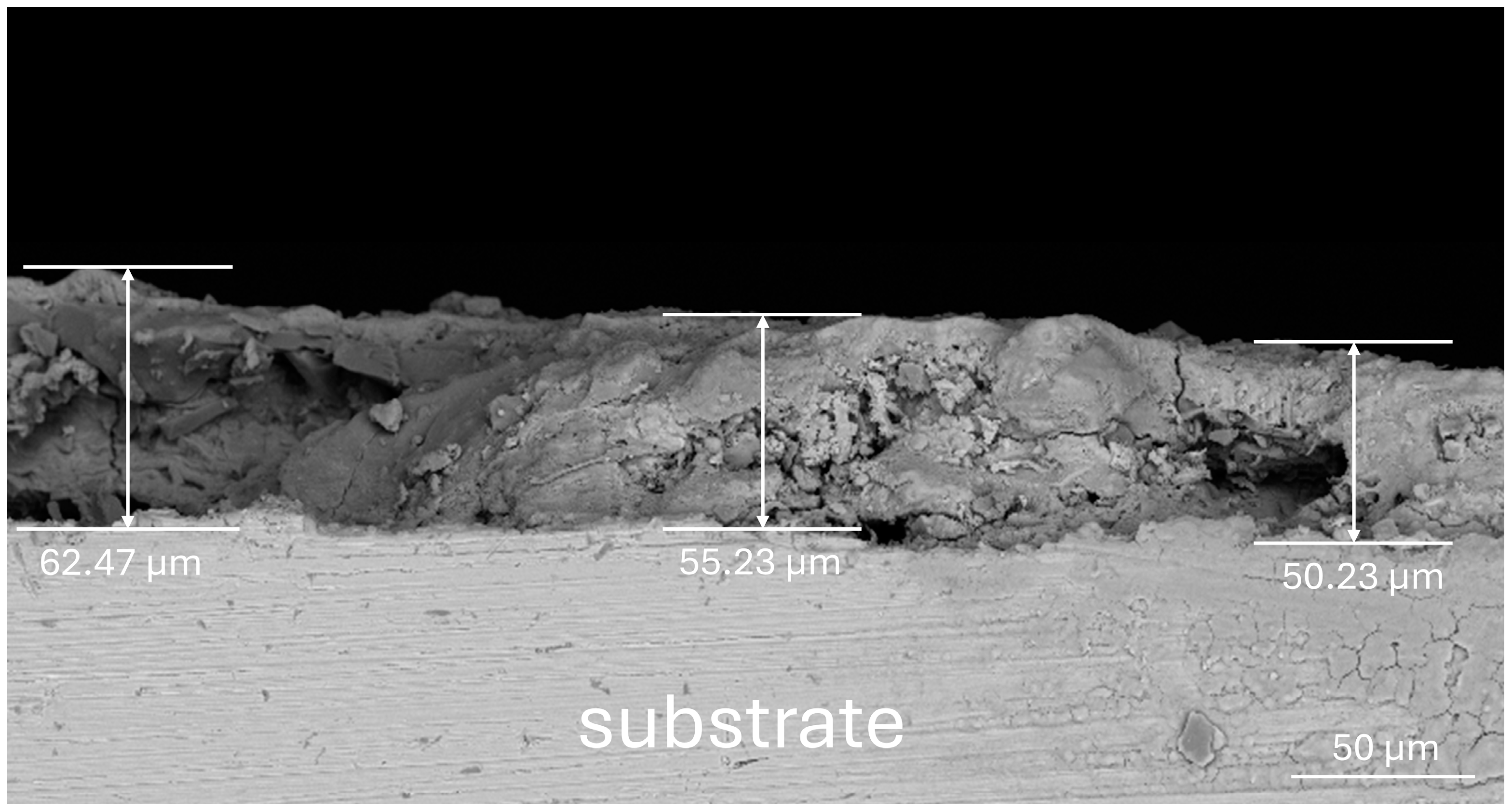
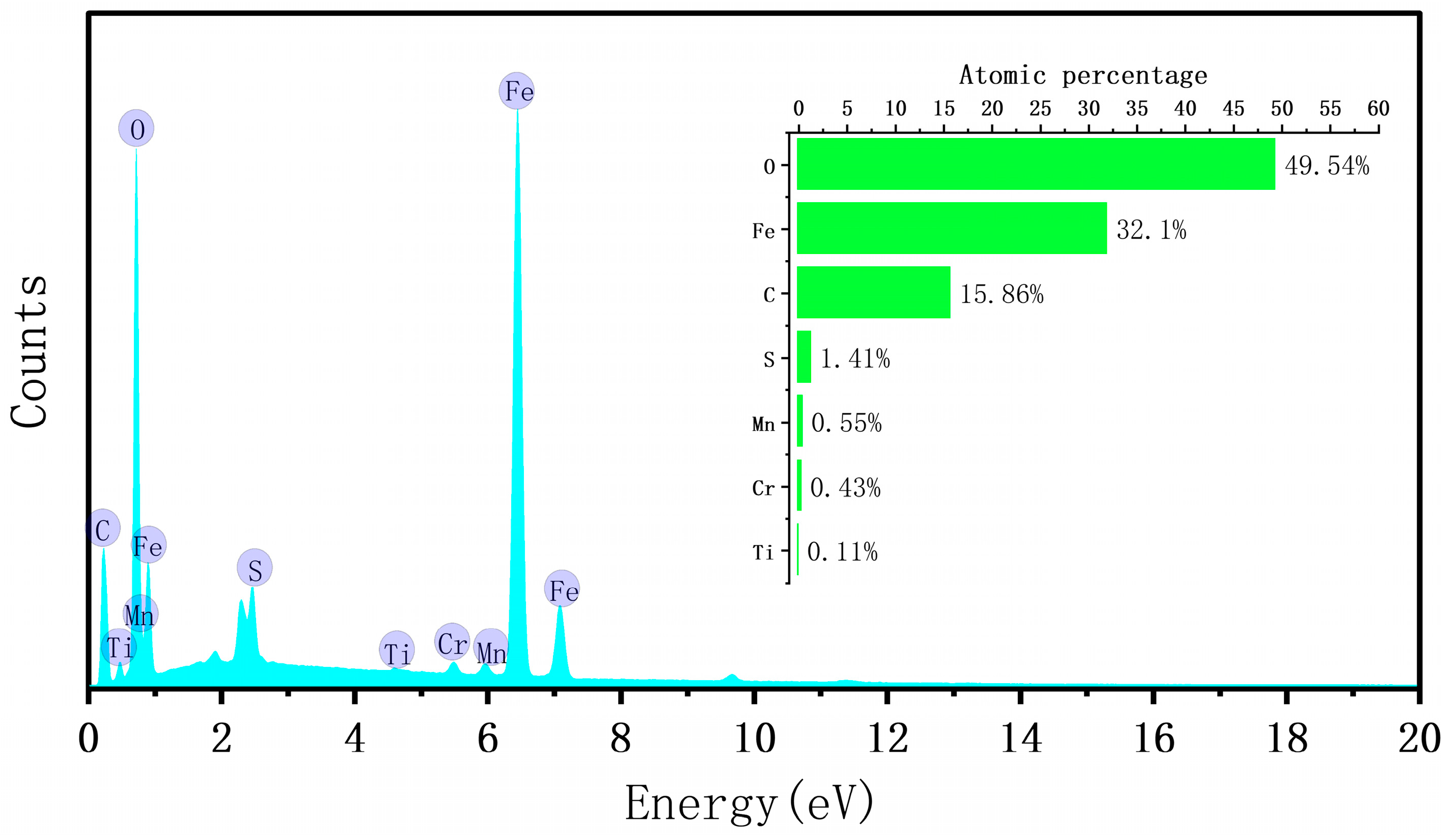
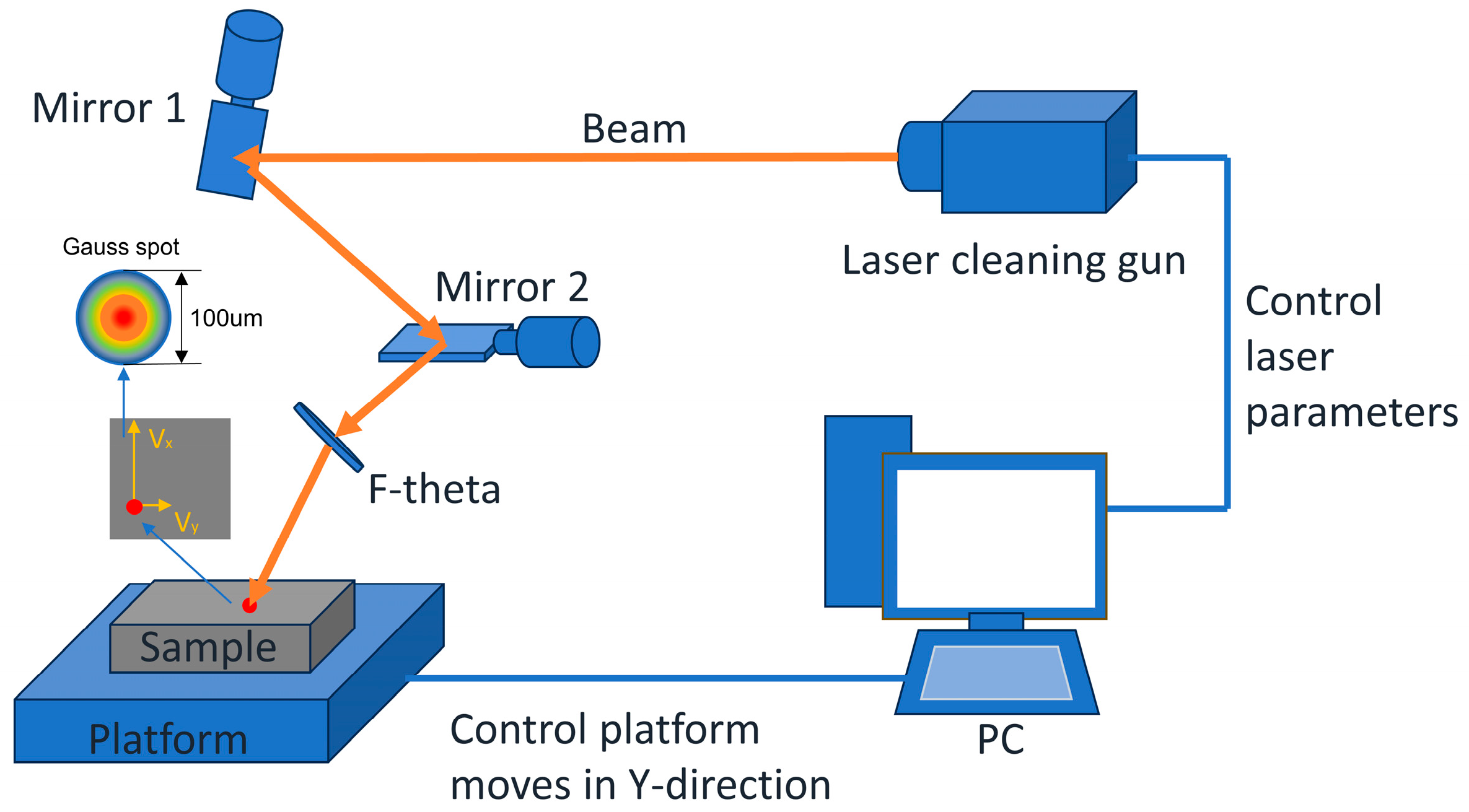
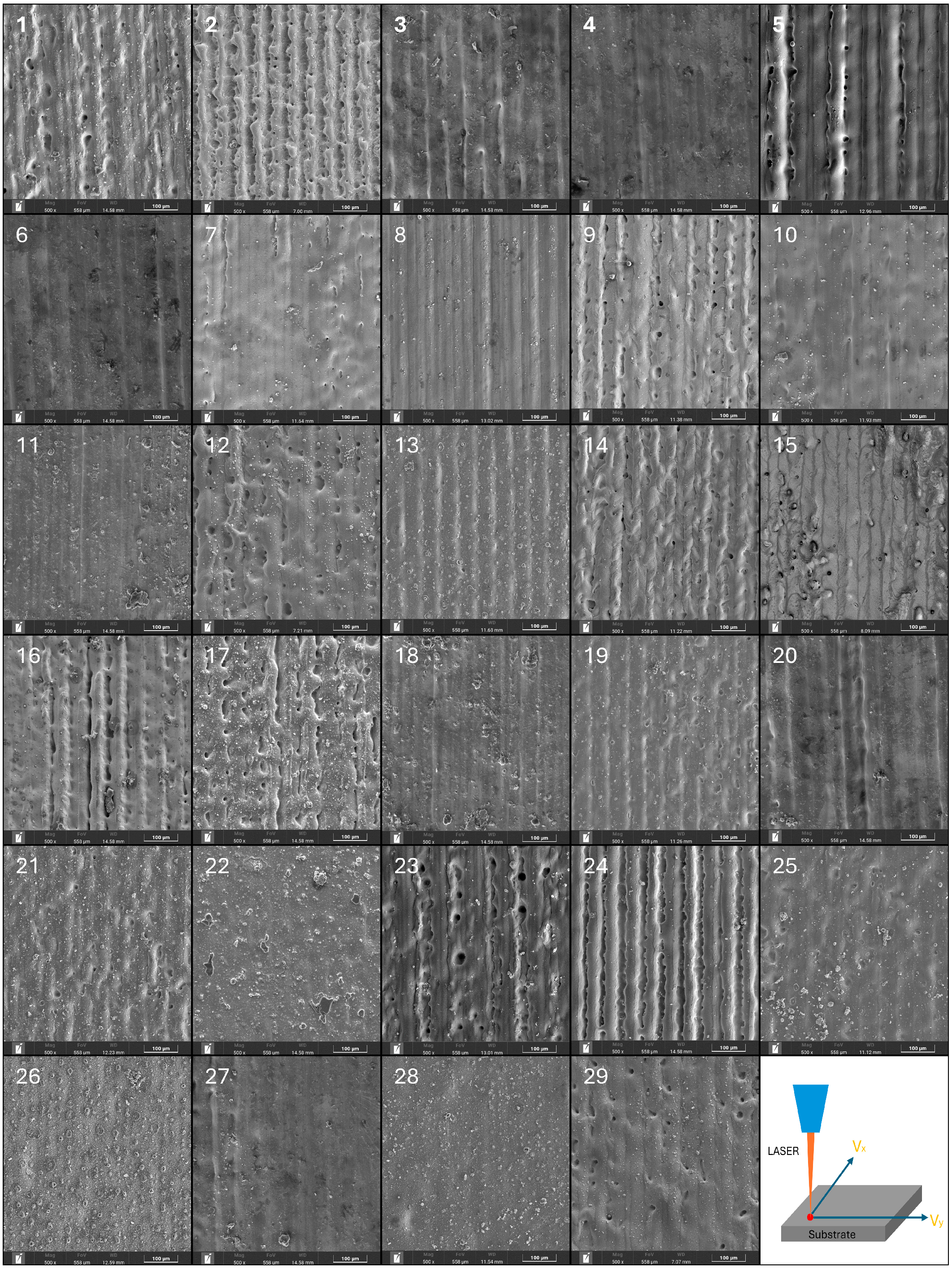
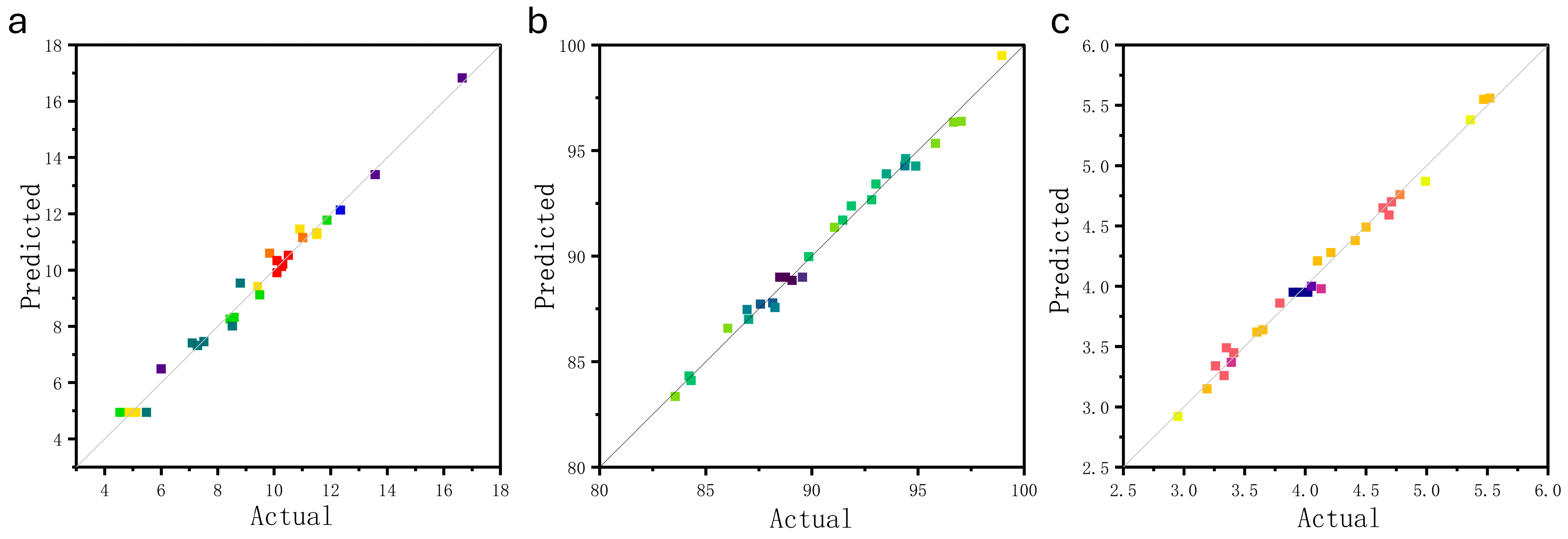
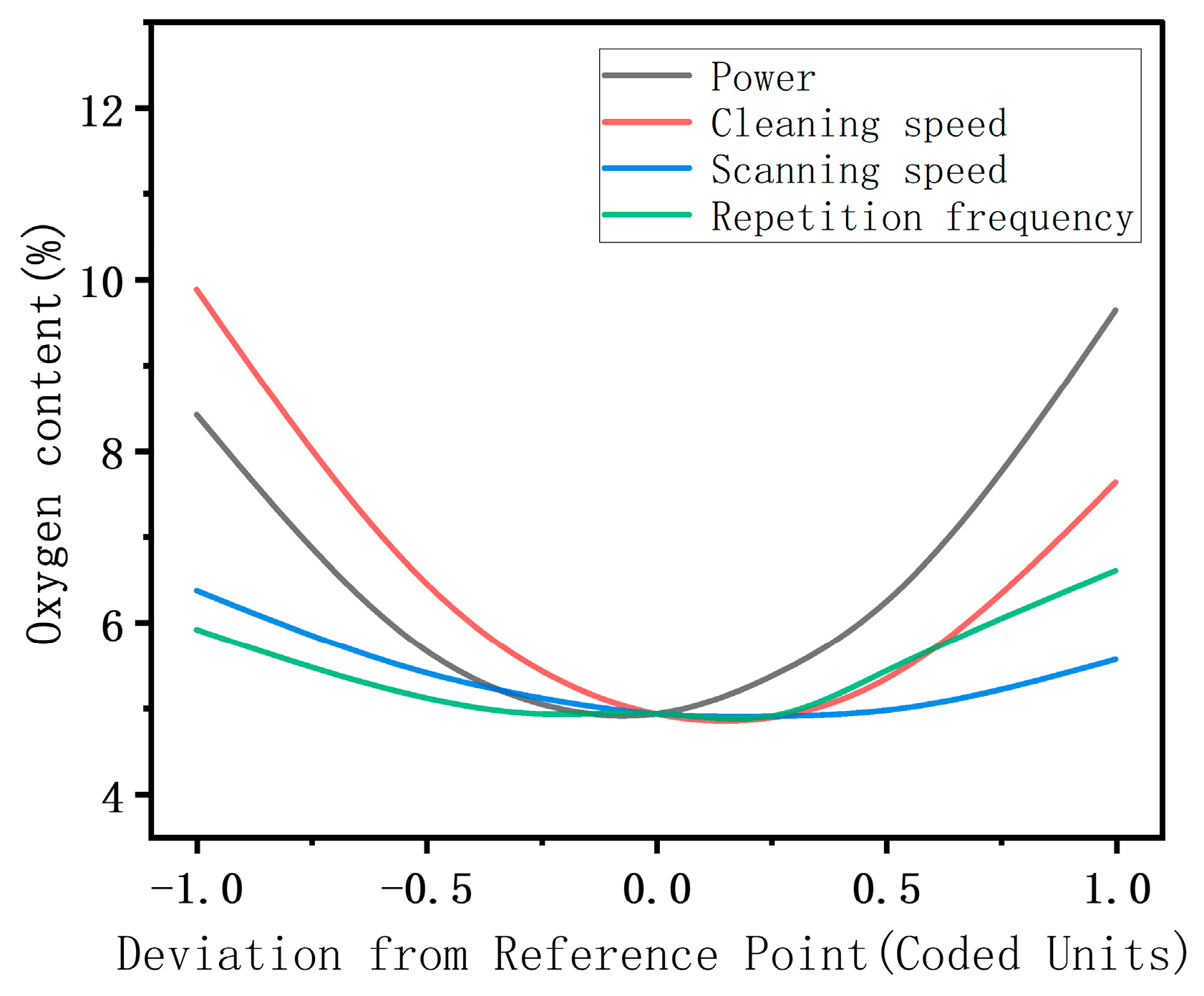

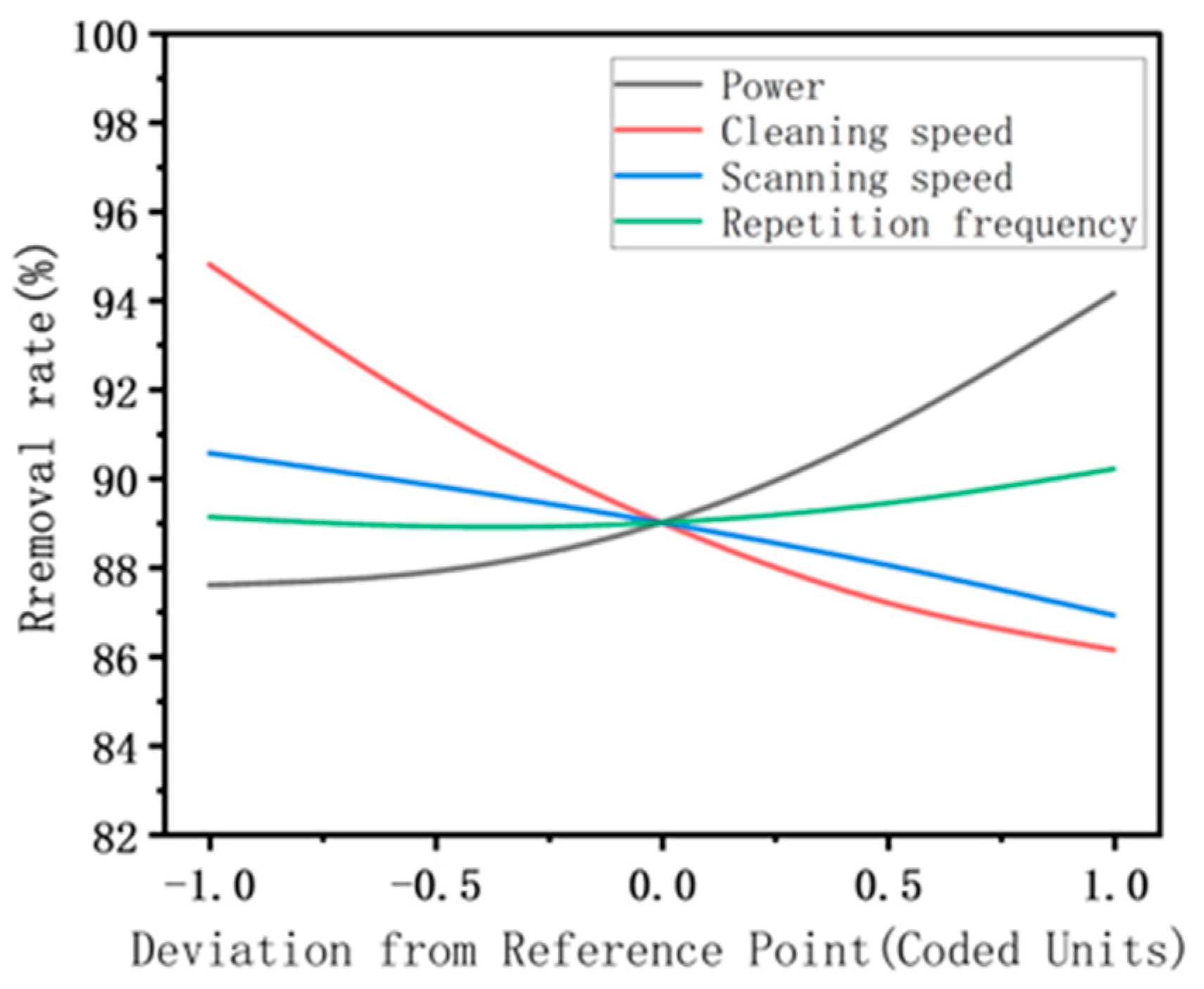





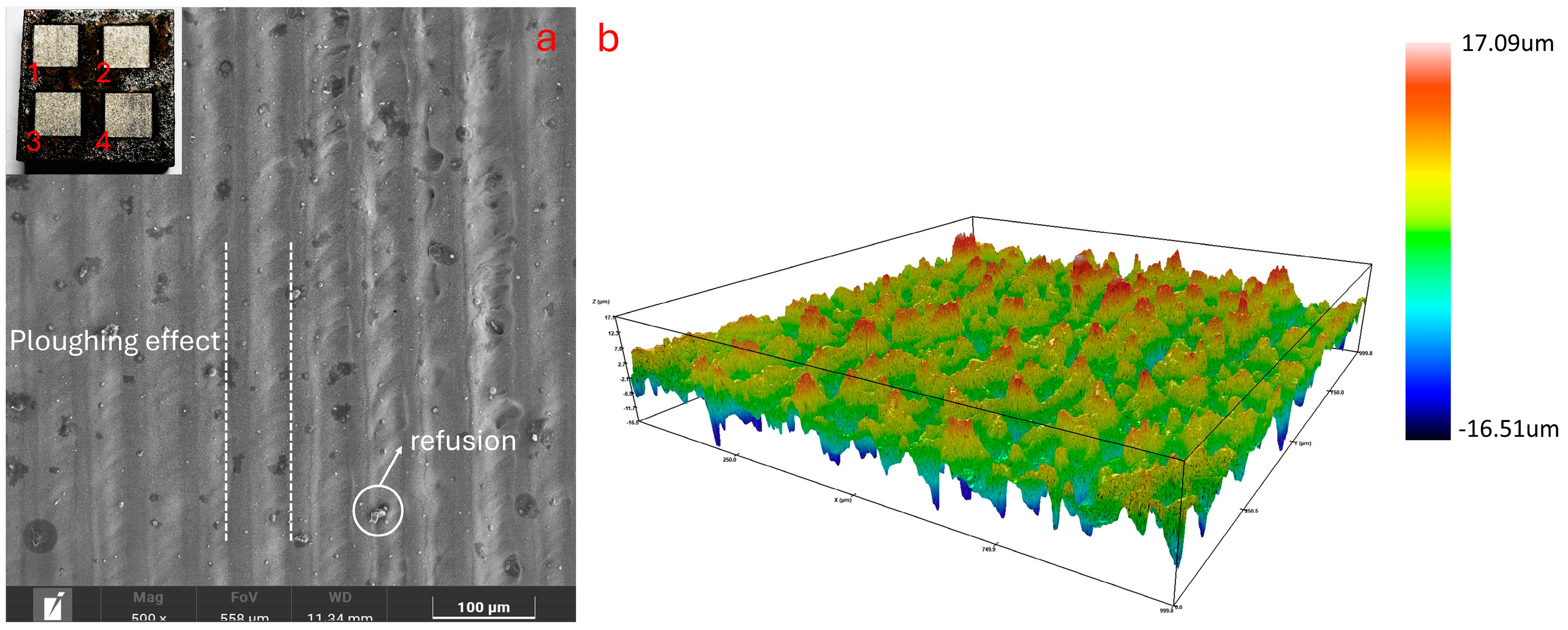
| Substrate | Laser Type | Ref. |
|---|---|---|
| Q345 | Solid-state laser with flat-top laser energy | [10] |
| AH36 | Ultraviolet nanosecond laser | [11] |
| Q345 | Nanosecond pulsed laser | [3] |
| Mild steel | Nanosecond pulsed laser | [12] |
| Q235B | 1080 nm continuous laser | [13] |
| Element | Fe | C | Mn | Si | S, P | Al | Ceq |
|---|---|---|---|---|---|---|---|
| Content (wt.%) | base | ≤0.20 | 1.00–1.60 | 0.55 | ≤0.030 | 0.038 | 0.37–0.42 |
| Thermophysical Parameter | Carbon Steel | Rust Layer |
|---|---|---|
| Destiny/(kg·m−3) | 7860 | 5200 |
| Thermal conductivity/(W·m−1·K−1) | 44.5 | 4.3 |
| Constant pressure heat capacity/(J·kg−1·K−1) | 600 | 900 |
| Absorption ratio | 0.49 | 0.8 |
| Melting temperature/K | 1808 | 1773 |
| Vaporization temperature/K | 3133 | 2973 |
| Parameter | Value |
|---|---|
| Wavelength | 1064 nm |
| Pulse width | 100 ns |
| Focused spot diameter | 100 µm |
| Laser power | 0–100 W |
| Repetition frequency | 10–100 kHz |
| Scanning speed | 0–8000 mm/s |
| Cleaning speed | 0–1000 mm/min |
| Variable | Code | ||
|---|---|---|---|
| Low (−1) | Medium (0) | High (1) | |
| Laser power (W) | 30 | 40 | 50 |
| Laser cleaning speed Vy (mm/min) | 150 | 200 | 250 |
| Laser scanning speed Vx (mm/s) | 2000 | 4000 | 6000 |
| Laser repetition rate f (kHz) | 80 | 100 | 120 |
| Run | P | Vy | Vx | f | O% | R% | Sa |
|---|---|---|---|---|---|---|---|
| 1 | 40 | 300 | 4000 | 80 | 7.11 | 86.04 | 4.7125 |
| 2 | 50 | 200 | 4000 | 80 | 11.89 | 94.89 | 5.5212 |
| 3 | 40 | 200 | 4000 | 100 | 5.49 | 88.49 | 3.8995 |
| 4 | 40 | 200 | 4000 | 100 | 4.57 | 88.64 | 3.9142 |
| 5 | 50 | 300 | 4000 | 100 | 10.28 | 91.45 | 4.9915 |
| 6 | 40 | 200 | 4000 | 100 | 4.88 | 88.75 | 3.9867 |
| 7 | 40 | 200 | 6000 | 80 | 6.01 | 87.58 | 4.0968 |
| 8 | 30 | 200 | 2000 | 100 | 8.81 | 91.47 | 3.7948 |
| 9 | 50 | 200 | 6000 | 100 | 10.12 | 94.38 | 4.4054 |
| 10 | 30 | 200 | 4000 | 120 | 11.53 | 89.06 | 2.9451 |
| 11 | 40 | 300 | 6000 | 100 | 8.45 | 84.31 | 3.6047 |
| 12 | 50 | 100 | 4000 | 100 | 16.67 | 98.95 | 4.7757 |
| 13 | 30 | 200 | 6000 | 100 | 9.43 | 83.56 | 3.1897 |
| 14 | 40 | 100 | 2000 | 100 | 11.52 | 97.03 | 4.5034 |
| 15 | 50 | 200 | 4000 | 120 | 10.32 | 95.82 | 4.2125 |
| 16 | 40 | 200 | 2000 | 80 | 7.52 | 89.85 | 5.3625 |
| 17 | 40 | 100 | 4000 | 80 | 12.36 | 94.42 | 4.6921 |
| 18 | 40 | 200 | 2000 | 120 | 8.53 | 91.86 | 4.1341 |
| 19 | 40 | 200 | 4000 | 100 | 4.55 | 89.56 | 4.0245 |
| 20 | 40 | 200 | 4000 | 100 | 5.12 | 89.56 | 3.9456 |
| 21 | 30 | 200 | 4000 | 80 | 8.59 | 88.15 | 4.0525 |
| 22 | 40 | 200 | 6000 | 120 | 7.29 | 86.95 | 3.3254 |
| 23 | 40 | 300 | 2000 | 100 | 9.51 | 88.26 | 4.6378 |
| 24 | 50 | 200 | 2000 | 100 | 10.93 | 96.02 | 5.4712 |
| 25 | 40 | 300 | 4000 | 120 | 9.86 | 87.02 | 3.3534 |
| 26 | 30 | 300 | 4000 | 100 | 13.59 | 84.21 | 3.3895 |
| 27 | 40 | 100 | 4000 | 120 | 10.12 | 96.69 | 3.4057 |
| 28 | 30 | 100 | 4000 | 100 | 11.03 | 93.57 | 3.2565 |
| 29 | 40 | 100 | 6000 | 100 | 10.52 | 92.82 | 3.6458 |
| Variance Source | Response Value | |||||
|---|---|---|---|---|---|---|
| Oxygen Content | Removal Rate | Roughness | ||||
| F-Value | p-Value | F-Value | p-Value | F-Value | p-Value | |
| Model | 71.16 | <0.0001 | 96.5 | <0.0001 | 105.78 | <0.0001 |
| A | 19.09 | 0.0006 | 376.23 | <0.0001 | 695.67 | <0.0001 |
| B | 65.76 | <0.0001 | 673.93 | <0.0001 | 1.53 | 0.2366 |
| C | 9.13 | 0.0092 | 114.53 | <0.0001 | 288.66 | <0.0001 |
| D | 6.35 | 0.0245 | 10.38 | 0.0061 | 453.14 | <0.0001 |
| AB | 87.74 | <0.0001 | 2.41 | 0.1428 | 0.1869 | 0.6721 |
| AC | 2.24 | 0.1567 | 58.53 | <0.0001 | 5.79 | 0.0305 |
| AD | 22.28 | 0.0003 | 0.0003 | 0.9865 | 1.1 | 0.311 |
| BC | 0.0039 | 0.9508 | 0.0503 | 0.8258 | 0.8397 | 0.375 |
| BD | 27.28 | 0.0001 | 1.24 | 0.2846 | 0.1441 | 0.7099 |
| CD | 0.0799 | 0.7816 | 5.19 | 0.039 | 5.69 | 0.0317 |
| A2 | 478.89 | <0.0001 | 68.8 | <0.0001 | 11.71 | 0.0041 |
| B2 | 417.69 | <0.0001 | 41.59 | <0.0001 | 0.0007 | 0.9799 |
| C2 | 30.51 | <0.0001 | 1.56 | 0.2317 | 15.79 | 0.0014 |
| D2 | 51.59 | <0.0001 | 8.68 | 0.0106 | 7.75 | 0.0146 |
| Lack of fit | 1.64 | 0.3345 | 1.34 | 0.4167 | 4.42 | 0.0826 |
| R2 | 0.9861 | 0.9897 | 0.9906 | |||
| Adjusted R2 | 0.9723 | 0.9795 | 0.9813 | |||
| Predicted R2 | 0.9316 | 0.9508 | 0.9493 | |||
| Adeq precision | 34.6257 | 38.7301 | 38.2623 | |||
| No | P/W | Vy/(mm/min) | Vx (mm/s) | f/kHz | O% | E% | R% | E% | Sa/µm | E% | |||
|---|---|---|---|---|---|---|---|---|---|---|---|---|---|
| Pre | Act | Pre | Act | Pre | Act | ||||||||
| 1 | 44.59 | 174.01 | 3852.03 | 116 | 8.65 | 8.48 | 2.01% | 94.71 | 93.85 | 0.9% | 3.9415 | 3.9039 | 0.96% |
| 2 | 33.31 | 173.29 | 4691.38 | 114 | 8.29 | 8.41 | 1.42% | 90.05 | 90.82 | 0.85% | 3.0111 | 3.1542 | 4.53% |
| 3 | 41.42 | 155.18 | 3922.68 | 117 | 9.71 | 9.59 | 1.25% | 95.85 | 93.11 | 2.94% | 3.6094 | 3.6854 | 2.06% |
| 4 | 44.29 | 177.49 | 3707.94 | 99 | 7.31 | 7.13 | 2.52% | 92.57 | 93.77 | 1.27% | 4.2975 | 4.3512 | 1.23% |
Disclaimer/Publisher’s Note: The statements, opinions and data contained in all publications are solely those of the individual author(s) and contributor(s) and not of MDPI and/or the editor(s). MDPI and/or the editor(s) disclaim responsibility for any injury to people or property resulting from any ideas, methods, instructions or products referred to in the content. |
© 2024 by the authors. Licensee MDPI, Basel, Switzerland. This article is an open access article distributed under the terms and conditions of the Creative Commons Attribution (CC BY) license (https://creativecommons.org/licenses/by/4.0/).
Share and Cite
Wang, G.; Deng, J.; Lei, J.; Tang, W.; Zhou, W.; Lei, Z. Multi-Objective Optimization of Laser Cleaning Quality of Q390 Steel Rust Layer Based on Response Surface Methodology and NSGA-II Algorithm. Materials 2024, 17, 3109. https://doi.org/10.3390/ma17133109
Wang G, Deng J, Lei J, Tang W, Zhou W, Lei Z. Multi-Objective Optimization of Laser Cleaning Quality of Q390 Steel Rust Layer Based on Response Surface Methodology and NSGA-II Algorithm. Materials. 2024; 17(13):3109. https://doi.org/10.3390/ma17133109
Chicago/Turabian StyleWang, Guolong, Jian Deng, Jieheng Lei, Wenjie Tang, Wujiang Zhou, and Zeyong Lei. 2024. "Multi-Objective Optimization of Laser Cleaning Quality of Q390 Steel Rust Layer Based on Response Surface Methodology and NSGA-II Algorithm" Materials 17, no. 13: 3109. https://doi.org/10.3390/ma17133109




